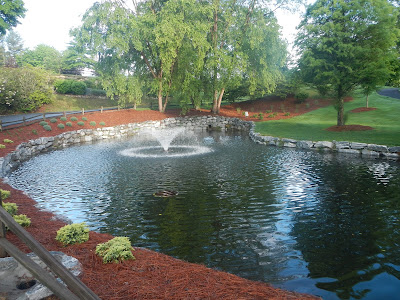With July 4th this coming Monday, we had to prepare the traditional American flag on the 17th fairway a few days early. This year, my two assistants, Josh Cantrell and Chris Cowan did most of the preparation and the heavy lifting (the painting and the clean-up). With outstanding weather, the job went nearly perfect and we again have that beautiful sight on the 17th fairway.
 |
| Simple tools for set up. |
 |
| The twine marks the boundaries of the "stars and bars". |
 |
| All of the paint must be mixed prior to application. |
 |
| Spray boards are used to keep the paint within the lines. |
For about 10 years now, the HFCC maintenance staff has been painting the American flag on #17 fairway. 17 was chosen as it provided a perfect position for the flag to be seen from the clubhouse. The flag measures 100 feet across and takes over 1500 feet of twine to set up. We use 10 gallons of red, 10 gallons of white, and 5 gallons of blue turf paint in addition to a case of white spray paint. We also go through a few pairs of old shoes and pants. From start to finish, it takes approximately 4 hours to complete.
 |
| Taking shape. |
 |
| Spray boards keeping the paint within the lines. |
 |
| The twine also helps line up the stars. |
 |
| Chris and Josh feeling good about their latest work of art. |
 |
| USA! |
A Brief History of the American Flag
The current official U.S. flag is a 50 star flag, born of the need for a more practical design to accommodate new states entering the union. On April 4, 1818, Congress established the number of stripes at seven red and six white, and provided the addition of one star for each new state. The thirteen stripes represent the original 13 colonies. The 50 star flag has been in use since July 4, 1960 when Hawaii officially joined the union.
In the first years of the Revolutionary War, America fought under many flags. One of these flags, called the Grand Union, flew over George Washington's headquarters near Boston. It was the first American flag to be officially recognized by another country.
 |
| Grand Union Flag |
On November 16, 1776, the American warship, Andrew Doria, saluted a Dutch fort in the West Indies and was saluted in return. This brought a measure of international recognition to the United Colonies. A flag with thirteen stars and thirteen stripes received its first salute from another country on February 14, 1778, when French vessels in Quiberon Bay, France, saluted John Paul Jones and his ship, "The Ranger."
No one positively knows who designed the first Stars and Stripes, or who made the first flag. Soon after the flag was adopted by our new government, Congressman Francis Hopkinson claimed that he had designed it. Some historians believe that Betsy Ross, a Philadelphia seamstress, made the first U.S. flag.
On June 14, 1777, in order to establish an official flag of the new nation, the Continental Congress passed the first Flag Act: "Resolved, that the flag of the thirteen United States be thirteen stripes alternate red and white; that the union be thirteen stars, white in a blue field, representing a new constellation."
 |
| 13 Star American Flag |
Today, that union consists of 50 stars representing all 50 states.
























